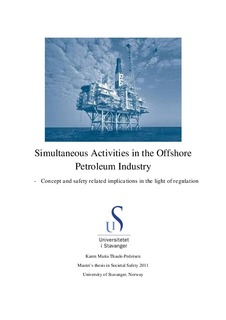| dc.description.abstract | This thesis is submitted in fulfillment of the requirements for a Master’s degree in Societal Safety at the University Of Stavanger, Norway. The thesis is a part of the project ―Robust regulation in the Petroleum Sector‖ funded by The Research Council of Norway, and directed from the University of Stavanger.
Accidents often have its root causes in organizational factors. Regulation is an important organizational factor and constitutes the motivational grounds for the choice of topic. The recent Deep Water Horizon accident in the US and several near accidents in Norway over the last few years have highlighted the importance of regulation, and demonstrated the relevance of this topic for a Master`s thesis. A basic assumption in this study is that simultaneous activities must be seen as a phenomenon with strong organizational implications. Hence, the study discusses how safety in these operational settings is handled through regulatory efforts in the Norwegian petroleum industry.
Norway’s goal-oriented, self regulatory style (re the internal control principle) is expected to produce benefits like increased innovation and development, a strengthened focus on operating responsibilities, and active ownership to rules and regulations. A drawback may be however that this internal control principle and the use of goal-oriented regulations along with legal standards, opens up for a considerable variation of unintended company interpretations. The understanding of hazards connected to certain activities may suffer accordingly.
The petroleum industry is complex and the inclusion of several stakeholders in simultaneous activities adds to this complexity. In my literature study on the same topics, written for the course “Risk Regulation and Audit” at the University of Stavanger in 2010 and leading up to this thesis, key results indicated that the goal-oriented legislation and other regulatory efforts (regulatory control components) surrounding simultaneous activities might lead to safety related problems in today’s petroleum industry, re considerable changes in both technical and operational conditions since these regulations came into force (“The Regulatory Regime for Simultaneous Operations in the Petroleum Industry”, Thaule-Pedersen, UiS 2010). The
findings in this study also indicated that the term ―simultaneous activities‖ exists in several variations and is used inconsistently.
The purpose of this Master`s thesis was to test these initial desk study results against corresponding empirical findings. The empirical findings are based on interviews with stakeholders at four levels in the industry; operator, rig-company, sub-contractor, and the Regulatory Forum (represented by informants from each side in the three-partite collaboration), who were asked about the phenomenon of simultaneous activities (concept, hazards, and regulatory control components).
The initial literature study findings are confirmed in this thesis, with these concluding comments:
- The understanding and risk evaluation of the phenomenon of simultaneous activities shows inconsistency and/or varies between core stakeholders in the offshore petroleum industry.
A correct interpretation of regulatory control components is important to achieve a common understanding and risk evaluation between the stakeholders of the industry. However, the regulation of simultaneous activities is in general not known by the informants and the interpretations seem to suffer from an unsatisfactory understanding accordingly.
- The regulatory control components addressing simultaneous activities have not been updated to comply with the new complexity of the offshore petroleum industry and might lead to increased risk.
Consequently, the unique arena for collaboration that exists between stakeholders and government in Norway might be even more valuable if today’s typically functional regulations were more concrete, and such measures could even be done in collaboration with the industry. More concrete regulations could also have given both the PSA and the industry more legal support. | en_US |
